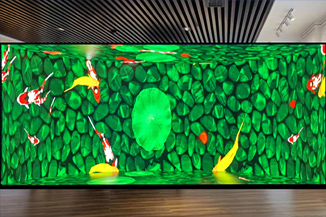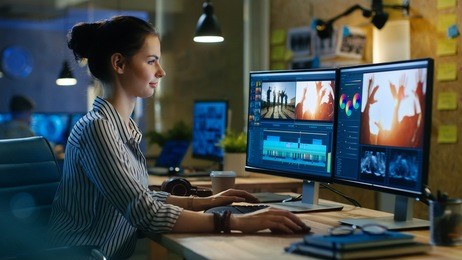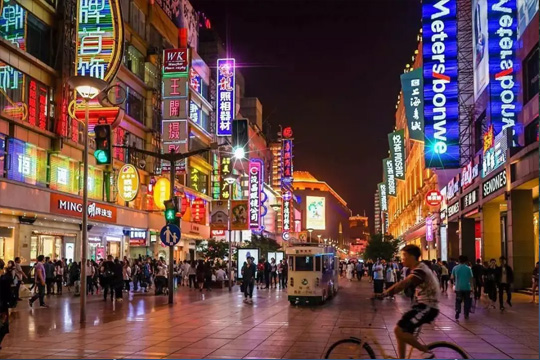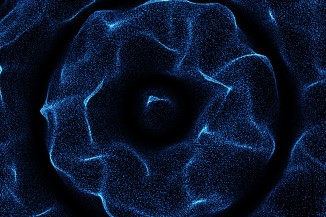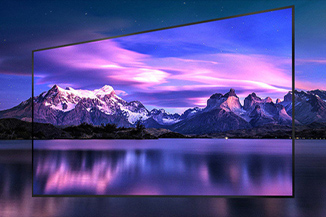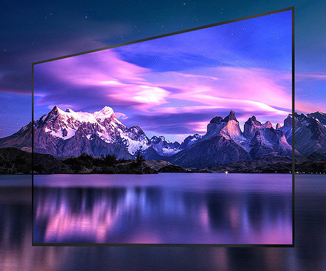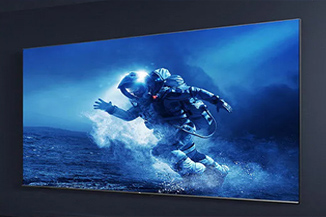Publisher: Supplier of LED Display Time: 2022-02-18 16:28 Views: 2100
In order to quickly judge the quality of the LED display, the editor of Lianchengfa has synthesized the following 9 important items of the LED display from various viewpoints. The first 8 items are suitable for general LED displays, and the 9th item is for small-pitch LED displays.
1. Maximum brightness: refers to the brightness of each primary color of the LED display at the highest gray level and the highest brightness under a certain ambient illumination. In short, it is the brightness measured by the light gun in the normal direction when the display is set to white 255 levels using the software. For outdoor LED displays, depending on the environment in which they are used, there will be different requirements for the maximum brightness, because in the case of strong ambient light, the brightness of the LED display is required to be higher, so that the masses can clearly see the content displayed on the screen. Under normal circumstances, the display screen facing south has lower requirements on the maximum brightness, as long as it reaches 4000CD/m2, it can meet the requirements, while the display screen facing south requires the brightness of the whole screen to reach 7000CD/m2, facing east and west with The requirements for facing south are the same, because there will be a part of the time when the sunlight will directly shine on the LED display. In theory, the brightness requirement is more than 5500CD square meters.
2. Color temperature: When we see that the color of the image is inconsistent or different from the material on the display, then our picture is seriously distorted, which is related to the color temperature of the white balance of the LED display. If the human eye directly watches the display Then the color temperature of its white balance is more suitable between 6500 and 8000K, and if it is a display screen used by TV stations, the actual color temperature of the screen body needs to be adjusted to about 5500K, so that the picture on the display screen is recorded and broadcasted by the camera. is real.
3. Refresh rate: The refresh rate refers to the number of times the information displayed on the LED display is completely displayed per second. If the refresh rate is too low, the LED display will shake when viewed by the human eye. Usually, we will see scan lines appearing when shooting with the camera. Usually, the requirement of the human eye for the refresh rate is above 300Hz, that is, as long as the refresh rate exceeds 300Hz, there will be no shaking feeling when viewing the LED display with the naked eye. If you use a camera to shoot, according to the different settings of different cameras, the minimum requirement is generally The scan line cannot be captured when the frequency is above 600Hz. High refresh can improve the brightness and color fidelity of the display. It can be detected with a digital camera. If it is a high refresh rate, the picture taken by the camera is very clear, without snowflakes and scan lines. This metric is especially important when it comes to rental screens and TV broadcasts.
4. Wavelength: The wavelength determines whether the color is pure or not and whether the color is consistent. The way to distinguish is very simple; if there is no professional equipment, how to distinguish with eyes? First: the whole screen is displayed in white, and the screen should be pure white without any other noise. If you think there is a little reddish or bluish, it proves that there are problems with the display material and process quality control. The longer it is used, the more serious it will become. Second: print out red, green, and blue monochromatic colors. The color of the central wavelength is what we usually call true blue, true red, and true green. If the color is darker or lighter, it proves to be a partial wavelength. If a certain color is inconsistent, it proves that the wave difference is too large. The high-quality display is in the range of the central wavelength, the blue-green wave difference is controlled at 3nm, and the red wave difference is less than 5nm.
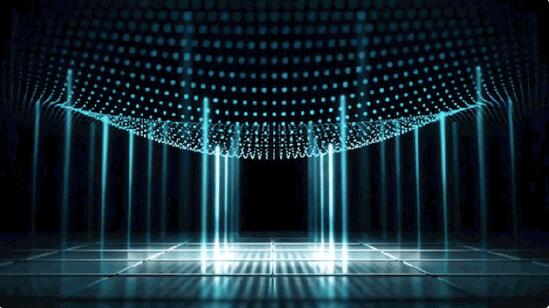
5. The viewing angle of the light-emitting tube: The light-emitting viewing angle of the light-emitting tube refers to the angle formed between the two observation directions of the same plane and the normal direction when the brightness in the observation direction drops to half of the brightness in the normal direction of the LED display. Divided into horizontal viewing angle and vertical viewing angle. For outdoor LED advertising displays, elliptical light-emitting tubes or SMD light-emitting tubes are generally used. The elliptical light-emitting tube has the characteristics of small angle and high brightness, while the vertical viewing angle of the SMD light-emitting tube is much larger than that of the elliptical tube, but its brightness is smaller than that of the elliptical light-emitting tube. , From the user's point of view, light-emitting tubes with different viewing angles should be selected according to the audience surface of the LED display screen and the surrounding light environment. For indoor LED display screens, because of their low brightness requirements and a wide audience, SMD LEDs are the best choice. It should be noted that, in order to reduce costs and confuse users, some manufacturers of LEDs in the market have made the brightness of LEDs higher and the viewing angle smaller than that of conventional LEDs, which will lead to LED displays. The brightness is very high when viewed from the front, but when viewed from a relatively large angle from the side, the image cannot be seen clearly. In order to improve the brightness of small-sized LED chips, small-angle packages are usually used. Large size does not require small angle packaging, because it does not require such high brightness. Therefore, a large angle (110) with high brightness and low current is the best.
6. Circuit design part: The design and materials of the circuit board play a vital role in the stability and display effect of the LED display. There are mainly the following requirements: 1. Material requirements: PCB thickness, generally 1.6mm thickness; Material: FR-4 glass fiber board, some manufacturers may use FR-2 paper substrate to reduce costs ;Copper foil thickness: The thickness of copper foil has a non-negligible effect on the heat dissipation of the PCB board and the stability of the circuit. The normal copper foil thickness is 35um (1Oz), and some manufacturers will use 18um (0.5Oz) copper foil thickness It is shoddy; so how can you tell the difference as a consumer? You can use an empty PCB to distinguish it by weight. Under normal circumstances, the heavier the better. 2. Several key points in design: connectors, connectors refer to the connection between the module and the module, there are two main types that are used more in the market now, one is the horn, the other is the row. Needle. The advantage of the horn is that the cable can be stuck by the two card positions, and it is not easy to cause faults caused by the connector problem. Regarding the choice of electrolytic capacitors and tantalum capacitors, for occasions requiring long life, tantalum capacitors are undoubtedly the first choice. Where a low price is required, electrolytic capacitors are the first choice.
Seven, automatic production equipment: most of the LED display is electronic components, and static electricity has a great harm to electronic components, sometimes static electricity directly breaks down components and damages them, sometimes it does not directly breakdown, but leaves The hidden danger, the side effect is that the components will be damaged after a period of use. In the electronics manufacturing industry, people have thought of many ways to deal with artificial static electricity, including wearing electrostatic rings, wearing electrostatic clothing, using dust-free workshops and so on. In fact, the most effective method is to try to avoid human hands touching electronic components, and the use of automated equipment achieves this purpose.
8. Average power consumption: Square power consumption refers to the power consumption generated by an LED display with an area of one square meter. The unit of power we usually say is watts/hour. For example, the power consumption of one square meter of LED display is 300 watts, then this display will consume 300 watts/hour of electricity per hour per square meter, which is what we often call 0.3 kWh. The power consumption of the LED display generally has two indicators, one is the maximum power consumption, and the other is the use power consumption. The maximum power consumption refers to the power consumption of the LED display at the maximum brightness. How to distinguish the maximum power consumption with eyes? The method is very simple: look at the number of power supplies behind the cabinet, multiply the maximum power of each power The maximum power consumption per square meter can be calculated based on the size. Generally, there are two types of power supplies, 200W and 300W.
Nine, indoor small spacing: low brightness and high gray, the specific explanation is: when the brightness range of the small spacing LED display is in the range of 100 cd/O-300 cd/O, the grayscale of the display screen is not lost, or the degree of grayscale loss. in a range that is imperceptible to the human eye. Low brightness and high gray will be one of the key factors to distinguish the quality of small-pitch LED display products. For small-pitch products, the competition of LED displays will no longer be about who has higher brightness, but who has lower brightness. Whose display can reduce the brightness without losing grayscale and picture quality. In other words, only a small-pitch LED display with low brightness and high gray is a good product that meets user requirements and has competitive strength. Under the dark indoor environment, the human eye looks at the high-brightness, small-pitch LED display at close range and for a long time. The unique high brightness of LED often makes people feel dazzling, and even causes sore eyes, tears and reduced vision. Therefore, the brightness of the LED display screen is too high, which will bring visual fatigue to users of indoor applications, and may even cause irreparable eye damage in serious cases! It can be said that the brightness of the small-pitch LED display screen is definitely not as high as possible. the brightness decreases. A large number of tests have shown that the brightness range of the LED display is controlled in the brightness range of 100 cd/O-300 cd/O, and the human eye feels more comfortable. But not directly adjusting the brightness of the display will solve this problem. Because the conventional LED display has the characteristics of low brightness and low gray, that is to say, when the brightness of the display decreases, it will be accompanied by the loss of the grayscale of the picture.
LCF Group specializes in the research and development, production and sales of LED display screens. It has rich industry experience, big manufacturers and big brands, and a complete service system. Customers in need can contact us for consultation.
